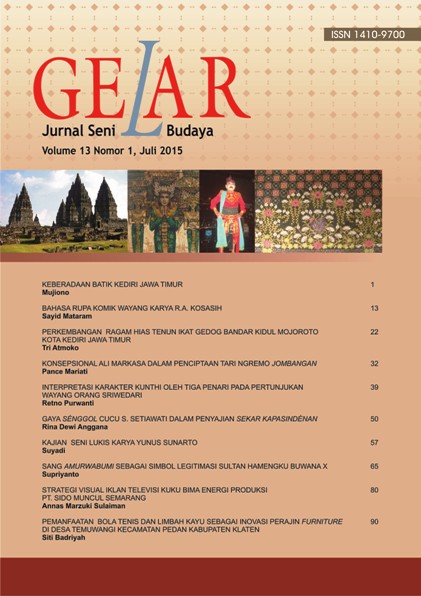GAYA SÉNGGOL CUCU S. SETIAWATI DALAM PENYAJIAN SEKAR KAPASINDÉNAN
Main Article Content
Abstract
The style senggol of a pasinden can be shown through a special song performance as a form of creativitythrough the development of the main melody or basic melody that is standard or not standard with a certainreureueus (ornamentation) technique supported by musical reference and self-potency. The journal is arrangedby using qualitative research method and musical approach that is more comparative in order to compare thesenggol of Cucu S. Setiawati with the senggol of Yoyoh S. Asih and Neni Hayati in the presentation of sekarkepasindenan entitled Kastawa, especially analyze about the form and the style of Cucu S. Setiawati’stypical senggol. By transcription and study of melody plot belongs to the song Kastawa presented by thethree pasinden, it can be concluded that the form of senggol Cucu S. Setiawati is different from the otherpasinden compared. The characteristic of Cucu S. Setiawati can be seen from the development of melodyand the use of reureueus technique based on her self-potency. She tends to confine herself in the presentationand it can be found in the using of the less and simple tone values and legato. The laras (barrel) used byCucu S. Setiawati is more various, laras rotation tends to be done at the end of song especially at matra 3-4 or at the last bait of song. Her typical Senggol also can be seen through the using of certain melodies whenshe faces nada kenongan and goongan, when nada is wider and its reach is higher. From the side of vocaltechnique, she uses masiep sora technique which is not used by the pasinden compared.
Keywords: style, sénggol, sekar kapasindénan, Kastawa, Cucu S. Setiawati
Downloads
Article Details
Copyright
Authors who publish with Gelar: Jurnal Seni Budaya agrees to the following terms:
- Authors retain copyright and grant the journal right of first publication with the work simultaneously licensed under a Creative Commons Attribution License (CC BY-SA 4.0) that allows others to share the work with an acknowledgment of the work's authorship and initial publication in this journal.
- Authors are able to enter into separate, additional contractual arrangements for the non-exclusive distribution of the journal's published version of the work (e.g., post it to an institutional repository or publish it in a book), with an acknowledgment of its initial publication in this journal.
- Authors are permitted and encouraged to post their work online (e.g., in institutional repositories or on their website) prior to and during the submission process, as it can lead to productive exchanges, as well as earlier and greater citation of published work.
